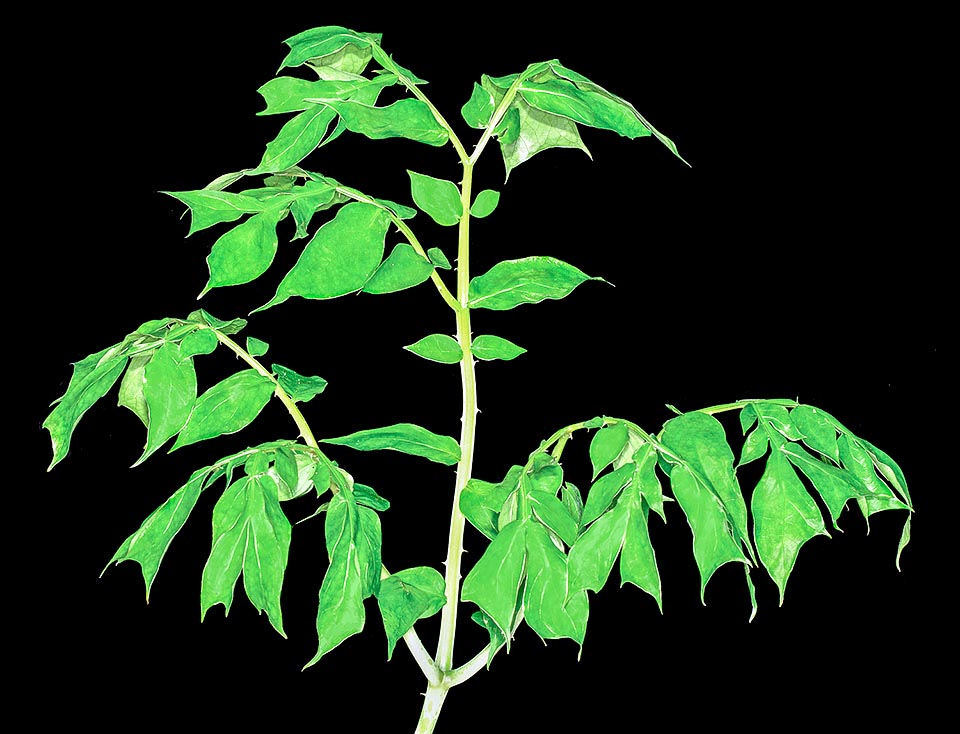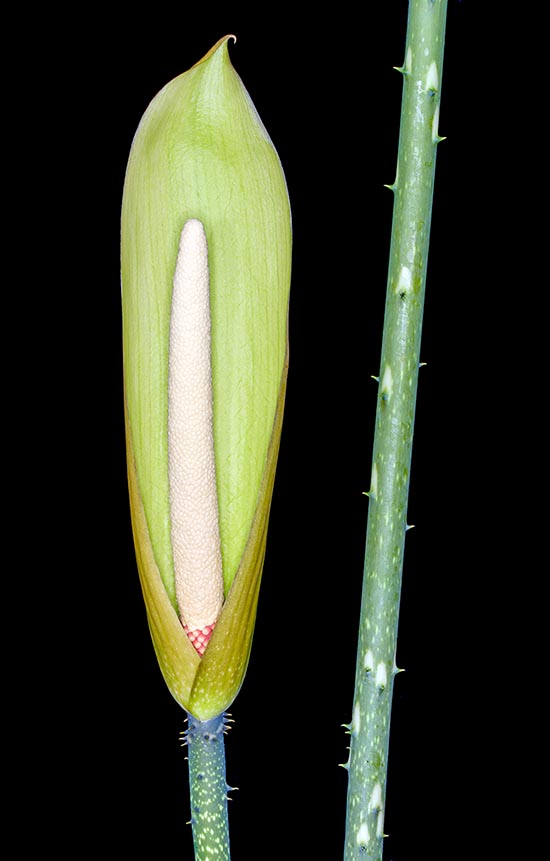Family : Araceae

Text © Pietro Puccio

English translation by Mario Beltramini
The species is native to Tropical Africa (Angola, Benin, Burkina Faso, Cameroon, Central African Republic, Chad, Democratic Republic of the Congo, Equatorial Guinea, Gabon, Gambia, Ghana, Guinea, Guinea-Bissau, Gulf of Guinea Islands, Liberia, Mali, Nigeria, Republic of the Congo, Senegal, Sierra Leone, Sudan, Tanzania, Togo, Uganda and Zambia) where it lives in the moist forests, savannahs and prairies, mostly along the water streams, at low and medium altitudes.
The name of the genus is the combination of the Greek verbs “ἄγχω” (ancho) = to tighten, to harass and “μαίνομαι” (mainomai) = to go crazy, one of the Greek names reported by Apuleius Platonicus in his “Herbarium” referred to the Dracunculus vulgaris Schott (1832); the name of the species is the Latin adjective “difformis, e” = uneven, of different shape (from other species).

Native to Tropical Africa the Anchomanes difformis is a perennial, herbaceous species, deciduous, with whitish horizontal tuber, 40-80 cm long and of 8-22 cm of diameter that generates, in the vegetative season, only one great solitary leaf, tripartite, with spiny segments, divided in their turn dichotomously, and sessile leaflets of variable shape. The tuber is edible, in periods of famine, after long boiling and washings to reduce its toxicity. Plant for magic rituals with medicinal virtues © Giuseppe Mazza
Common names: children’s umbrella, God’s umbrella (English); agbanhan, jinwo hwéxè (Benin); alomé, blima, dobli, niamatimi, séréousso kwama, yaprè (Ivory Coast); atoe, doli, nyame, ope (Ghana); abirisoko, bugulli, chakara, hantsar gada, igo, langbodo, ogirisako, olumahi (Nigeria); dinkondo dia kimbiti (Democratic Republic of the Congo); éken (Senegal); bothigba, kiponi, pondi (Sierra Leone); adanlé (Togo); kabaka-kachulu (Zambia).
The Anchomanes difformis (Blume) Engl. (1879) is a perennial, herbaceous species, deciduous, with whitish horizontal tuber, 40-80 cm long and of 8-22 cm of diameter, with the evident annular scars of the junction of the leaves and fleshy roots. The tuber produces in every season one solitary leaf, 0,8-1,5 m broad, tripartite with spiny segments, divided in their turn dichotomously, and sessile leaflets of variable shape, usually bicuspid, 8-18 cm long and 3-6 cm broad, of intense glossy green colour. Petiole, 1-2,5 m long and of 1-4 cm of diameter, of purple greenish colour with irregular white dots and white greenish spines about 3 mm long.

The inflorescence, protected by a 10-25 cm spathe, is carried by a 0,5-1 m petiole, also spiny. It attracts numerous coleopterans with a strong smell and increasing the temperature inside same © Giuseppe Mazza
From the tuber emerges an inflorescence, on a peduncle similar to the petiole, 0,5-1 m long and of 0,7-1,2 cm of diameter, formed by a sessile spadix almost cylindrical with rounded apex, 5-16 cm long and of 1-1,5 cm of diameter slightly decreasing towards the apex, with unisexual flowers, the female, with pink purple ovary, arranged in the lower part per a length of 2-5 cm, followed by the male ones of white cream colour.
The inflorescence is surrounded by an oblong spathe with acuminate apex, 10-25 cm long and 4-6 cm broad, of pink to purple or green suffused of purple colour on both sides, or purple externally and pale green below, with overlapped inferior edges.
The flowers are pollinated by coleopterans (Nitidulidae) attracted by the strong odour and by the increase of temperature of the spadix in respect to the environmental one.
The fruits are ovoid berries usually white initially, then red purple when ripe, 1-5-2 cm long and of about 1 cm of diameter, containing only one seed 1,3-1,5 cm long and of about 0,8 cm of diameter.
It generally reproduces by seed, cleaned from the pulp, in draining loam rich of humus maintained constantly humid at the temperature of 26-28 °C, with quite variable germination times, starting from 3 weeks; the first leaf is entire and sagittate.
The tubers are consumed in times of famine, but after long boiling and repeated washings due to their toxicity, because of the presence of saponin and of calcium oxalate crystals.
The species has an important role in the magic rituals and in the traditional medicine of the local populations, decoctions of the different parts are utilized for various pathologies, among which dysentery, diabetes, venereal illnesses, respiratory diseases, hypertension and as diuretic and laxative, but clinical studies have revealed a high toxicity at kidney level in case of excessive consumption.
Laboratory studies on extracts of leaves, tuber and roots have evidenced interesting analgesic, antibacterial, anti-malarial, antioxidant and antipyretic properties.
Finally, are not to be undervalued its ornamental characteristics, utilizable in the tropical and subtropical gardens in shady or semi-shady position on soils, slightly acidic to slightly alkaline, maintained constantly humid.
Synonyms: Amorphophallus difformis Blume (1837); Caladium petiolatum Hook. (1840); Pythonium hookeri Kunth (1841); Anchomanes hookeri (Kunth) Schott (1853); Anchomanes dubius Schott (1860); Anchomanes hookeri var. pallidus Hook. (1863); Sauromatum ferox Linden ex Engl. (1879); Anchomanes welwitschii Rendle (1879); Cyrtosperma congoensis L.Linden (1879); Anchomanes obtusus A.Chev. (1909); Anchomanes difformis var. welwitschii (Rendle) Engl. (1911); Anchomanes petiolatus (Hook.) Hutch. (1936).
→ To appreciate the biodiversity within the ARACEAE family, please click here.
